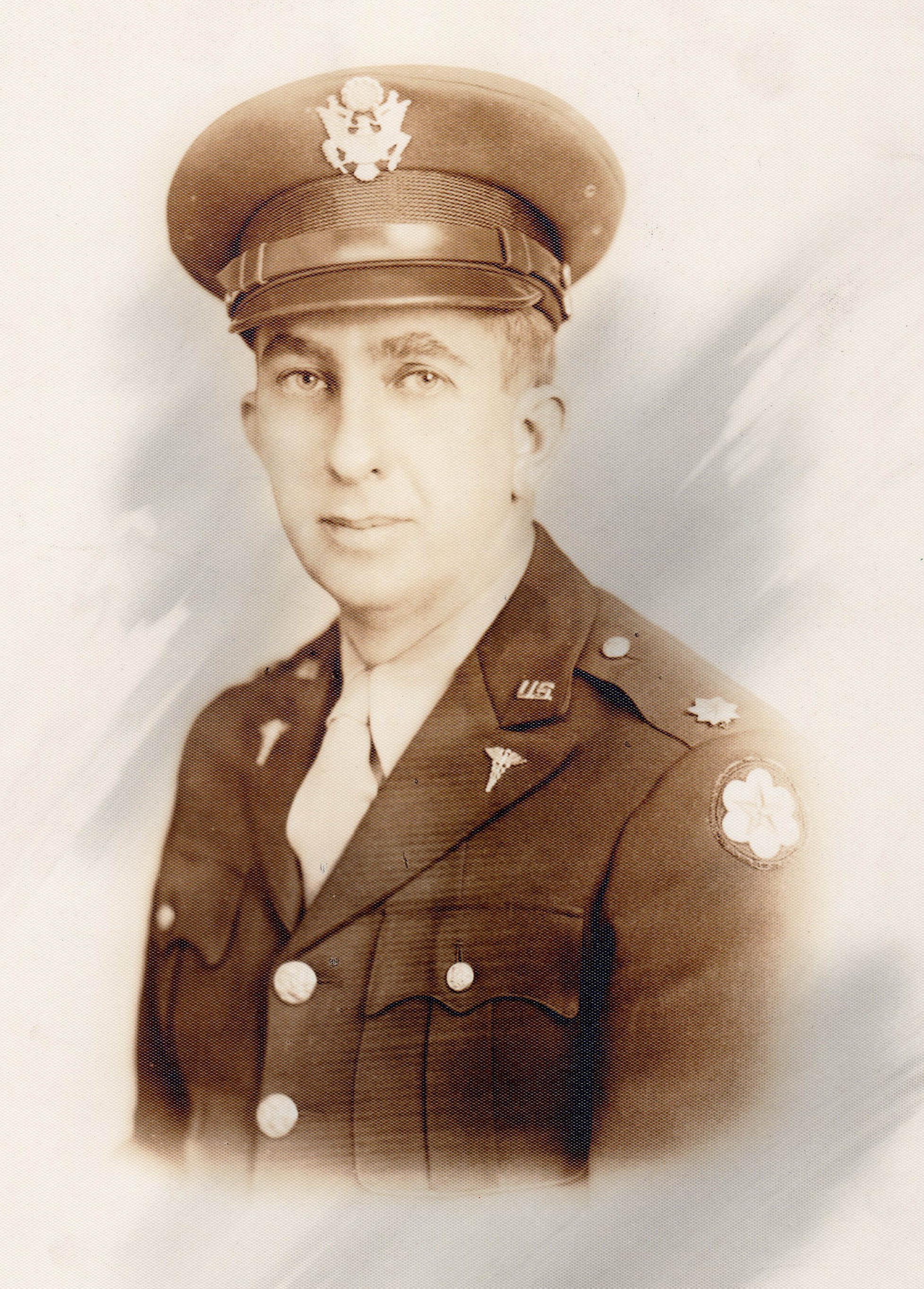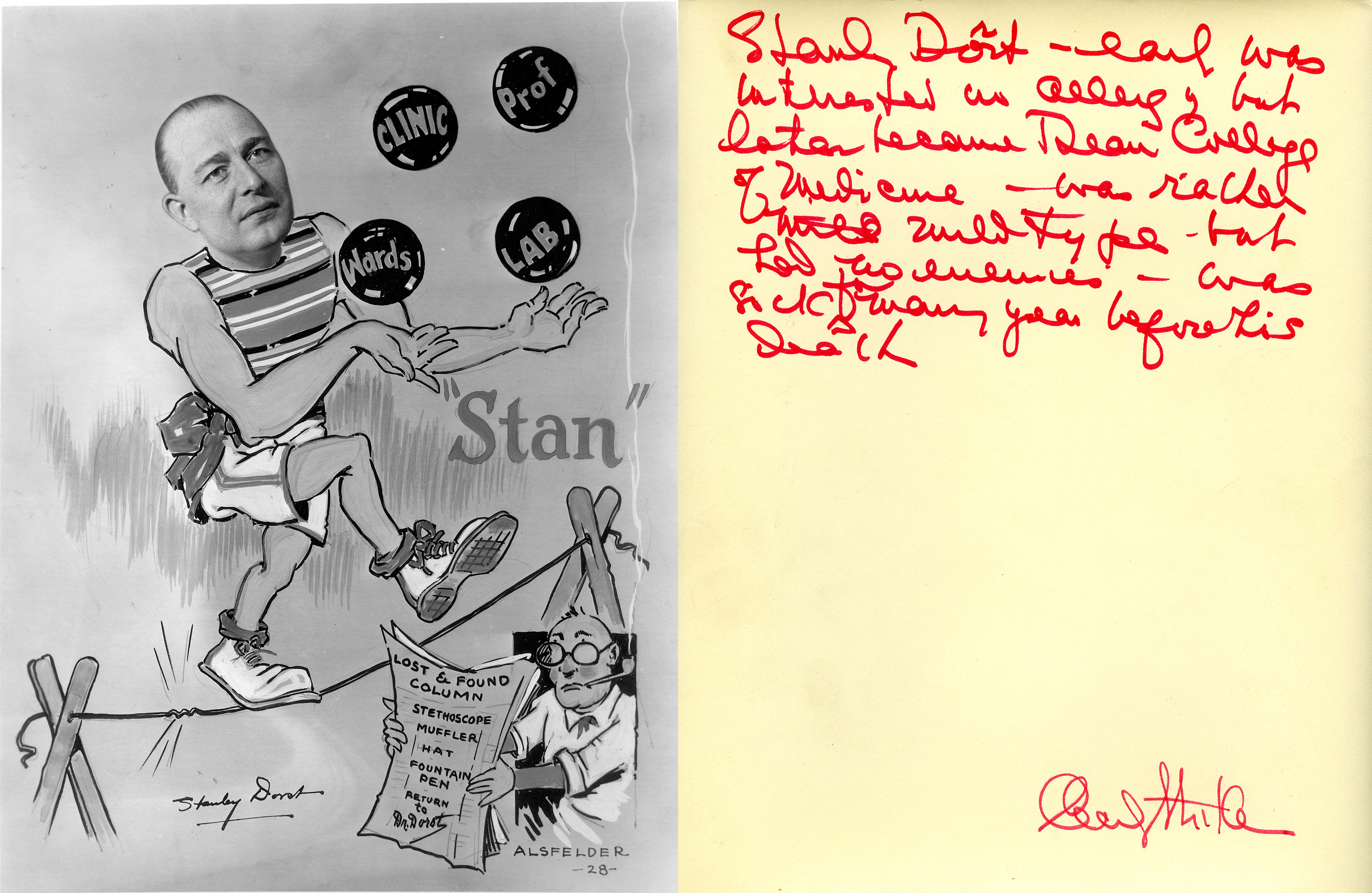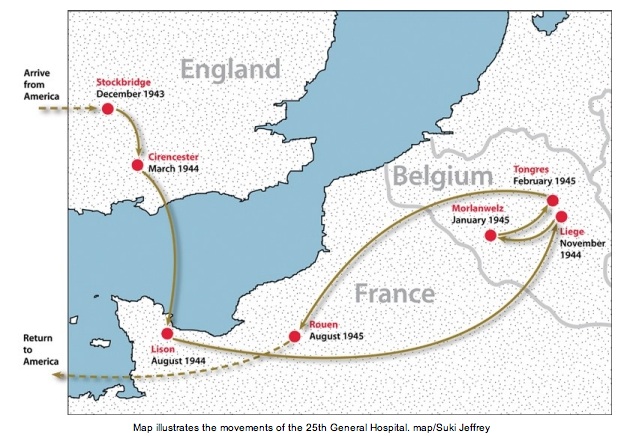
Murray Lambert Rich, MD: husband to the former Miss Mabel Burrows and father of
John M. Rich, James B. Rich, and Charles L. Rich.
This photo serves as a link to the blog,
“A Special Visit with Dr. Rich.
By: Nathan Hood
In the summer of 1941, the United States federal government requested that the Cincinnati General Hospital – now a division of the University Hospital – organize the 25th General Hospital. Intended as a military organization similar to the one during WWI by the same name, the project gained momentum after Pearl Harbor on December 7, 1941. The General Hospital was soon after “ordered into active military service … on June 1, 1943.” The 25th was fully organized by June 10, 1943, at Nichols General Hospital. The General Hospital began with 500 enlisted men, 56 military officers (physicians from the Cincinnati General Hospital), 105 nurses, 3 hospital dietitians, 2 physio-therapists, and 1 warrant officer. The 25th was trained at the Medical Field Service School, Carlisle Barracks, in Pennsylvania. Part of this training required the entire organization (exempting female personal) to complete a 10-day “bivouac” at Ft. Knox, Kentucky, from the 17th to the 26th of July, 1943. Here the 25th was rigorously tested under field conditions.
Dr. Murray Lambert Rich became an official Major of the USA Military at Ft. Knox presumably while attending the 25th’s bivouac in 1943. A 1929 Graduate of the University of Cincinnati College of Medicine, Murray Rich had interned at the Cincinnati General Hospital in 1928 and had since become an “Assistant Resident,” maintaining this position from 1929 to 1932. At some point, he also became an assistant professor of internal medicine. He would ultimately serve “39 months with the Twenty-fifth Hospital Unite.”

‘Alsfelder’ caricature of Dr. Stanley E. Dorst. According to Colonel Nimitz, one of four individuals particularly responsible for supervising the selection of staff for the 25th General Hospital.
Miss Hattie Pugh assisted in the selection of nursing personnel.
This image serves as a link to the blog, “Magnifying the Past: The ‘Alsfelder’ Faculty Caricatures.”
Barbara Lincoln Ashbaugh joined the American Red Cross in World War II as a psychiatric social worker. She trained for two weeks in Washington starting November 1, 1943, and like Murray Rich, she would also complete a kind of preliminary “field experience” beginning November 16th, 1943, in South Carolina. She was one of five civilian Red Cross workers assigned to the 25th General Hospital, the others: Helen Delbauve, Ruby Greiling, Anne Finucane, and Vera Whitney. These five joined the 25th General Hospital at the “port of embarkation” on December 9, 1943, where the 25th General Hospital eventually left for the European Theatre of Operations on December 23, 1943.

Map of the movements of the 25th General Hospital: note the location of
Lison, Liège, Morlanwelz, and Tongres.
Many events surrounding the 25th General Hospital and its movements throughout Europe may be explored; however, the majority of the Hospital’s experience in Belgium is perhaps of particular relevance and interest today. Regardless, very generally, the 25th operated by requisitioning and repurposing various buildings at each of their assigned locations. Thus, after “[t]he hospital plant at Lison, France, was turned over to the 195th General Hospital … on November 23, 1944,” the 25th General Hospital commenced moving to Liège, Belgium, where they had intended to occupy the city’s Palace of Justice. The move was successfully effectuated on November 29th, 1944; however, local officials refused to relinquish the building. Without a central area of operations, nurses and enlisted personnel were “billeted” through December to a school and apartment building, respectively, and sporadically utilized on “detached service and temporary duty.”
At this time, the entire surrounding city of Liège was experiencing intense bombing – “the average of one every ten minutes day and night” – very fortunately without a single casualty belonging to the 25th General Hospital. This is rather miraculous given that “[m]ore than half the houses in Liège were destroyed.” In contrast to the 25th, the Belgian population endured something like 5,000 deaths and 21,000 cases of injury within six months. Bombing was concentrated from about the middle of November 1944, to the middle of January 1945. In her Memoirs, Ashbaugh confesses that: “[i]t still terrifies me to write about the Belgian experience” and that “[e]very day was dominated by the emotion of fear – fear that the exploding bombs would wipe us all out.” The 25th General Hospital was understandably considering other locations:
“The Second site considered in which to establish the 25th General Hospital was the Belgian Caserne at Tongres, Belgium, approximately 12 miles northwest of the city of Liege. This site consisted of 5 modern brick buildings built on a quadrangle.”
“When the Germans found it necessary to withdraw from Belgium they attempted to burn and destroy the buildings to the greatest extent possible in the limited time available”

Photographs of Morlanwelz presumably from Barbara Ashbaugh’s scrapbook.
This image serves as a link to more photos concerning the 25th General Hospital.
Both Ashbaugh and (very probably) Dr. Murray Rich worked with the surrounding hospitals during the 25th’s stay in Liège. In late December of 1944 though, Ashbaugh recounts how she witnessed American tanks retreating from the Battle of the Bulge. In January, the 25th necessarily then moved to Morlanwelz because the location in Tongres had remained unsuitable; regardless, Ashbaugh describes the change as an immense relief. The 25th would stay in Morlanwelz for a little less than a month only to arrive at Tongres by February 20th, 1945. At Tongres, the Red Cross volunteers were generously ‘given’ a barn on the property, which was then repurposed and outfitted for their personal convenience. By March 25, the hospital had rapidly reached its total capacity: 1250 beds. V-E Day was announced a bit later on May 9, 1945.

Dr. Murray Lambert Rich among other officers of the 25th General Hospital on the
steps of one of the Belgian Caserne buildings. Not all officers are present.
Despite the fantastic, modern significance of the University of Cincinnati’s Twenty-Fifth General Hospital, relevant historical information remains fairly limited or otherwise not readily accessible. Consequently, the public does not generally know about this portion of the University’s history.
I must mention, perhaps even dolefully, that the information for this article would likely not have even existed if not for the dedication of two people: Barbara Lincoln Ashbaugh through her Memoirs and Colonel H.J. Nimitz in A Brief Historical Sketch of the 25th General Hospital In World War II. Many Regards to them: it was their hope that information on the 25th General Hospital be preserved and recognized as a significant portion of the University’s history in subsequent years.
Contributing to the fulfillment of this wish today, Dr. Charles Lambert Rich has made a commendable effort of developing the 25th’s history through exploring the life events of his father, Dr. Murray Lambert Rich. His findings will be shared and preserved along with other information on the 25th General Hospital at The Henry R. Winkler Center for the History of the Health Professions.
The upcoming blog exploring the history of the 25th General Hospital will include insights generously shared by Dr. Charles Rich!
For more information, to view a collection, or for a tour of the Winkler Center, please call 558-5120 or email chhp@uc.edu to schedule an appointment.


